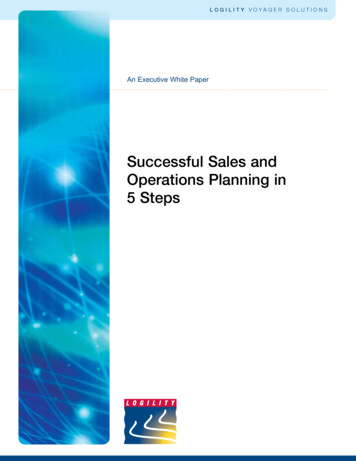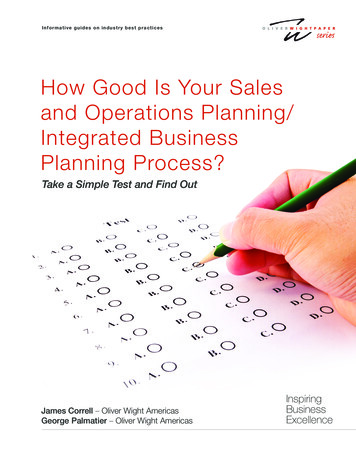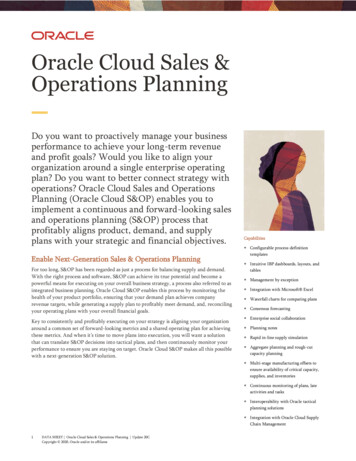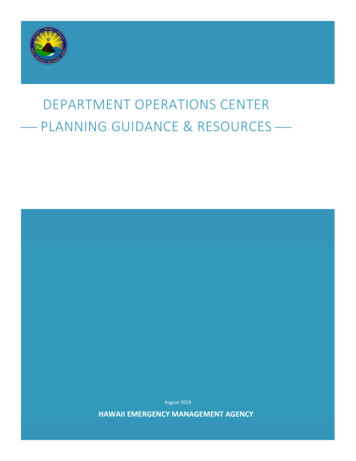
Transcription
L O G I L I T Y V O YA G E R S O L U T I O N SAn Executive White PaperSuccessful Sales andOperations Planning in5 Steps
L O G I L I T Y V O YA G E R S O L U T I O N SAn Executive WhitepaperSuccessful Sales and OperationsPlanning in 5 StepsExecutive OverviewThe Sales and Operations Planning (S&OP)1 process is well known and understoodin the world of supply chain management. In most companies, the monthly S&OPmeeting brings executives from all major operational departments – sales, marketing,materials/procurement, manufacturing, transportation, and finance – together todetermine how best to manage company resources to profitably satisfy customerdemands over the next quarter, year and beyond.The monthly S&OP meeting is a critically important, high-level decision-makingactivity that sets the overall direction for the company. Executives discuss the varioustrade-offs between customer service, inventory investments, production capabilities,supply availability, and distribution concerns. In essence, the executives determinehow the company’s resources will be spent in an effort to strike an optimumbalance between what generates the most profit and satisfying the company’s mostimportant operational goals.There’s no debate, S&OP cannot be completed effectively without reliable, accurateinformation. The S&OP team must have up-to-date information regarding futuretime-phased demand, production capabilities, inventory status, and any limitationson resource availability such as warehouse space, transportation capacity, limits oncash or credit, and their influence on each other and overall company results.There are a number of tasks and analyses that need to be completed prior to eachexecutive S&OP meeting to make the most efficient use of the monthly planningsession. These include: Innovation and Strategy Review – impact of New Product Introductions (NPIs) Demand Review – includes base-line demand as well as demand sensing anddemand shaping activities Supply Review – monitor inventory levels and production capabilities Financial Integration – ensure balanced demand and supply plans meetcompany financial objectives and are within working capital constraints Executive Business Review – executives from all major departments reviewfuture plans and impactThese tasks gather and prepare the information the S&OP team needs to fullyunderstand the range of considerations that must be included in their decisionmaking. Armed with this information, the S&OP team can make the tough decisionsthat will ultimately determine how well the company performs, regardless of thepriorities and challenges.This process is also called SIOP – Sales, Inventory and Operations Planning. The objectives and the process are the same. Use of theterm S&OP is not meant to imply, in any way, any diminished importance of inventory planning.1Table of ContentsS&OP Process Challenges.35 Steps to S&OP Success.5Step 1 Innovation and Strategy Review.5Step 2 Demand Review.6Demand Sensing.6Demand Shaping.7Step 3 Supply review.7Inventory Optimization.7Operations Planning.8Step 4 Financial Integration.9Step 5 Executive Business Review.10A Plan Goes in to Action.11Table of FiguresFigure 1: Over half the industry relies onExcel, Access or PowerPoint for S&OP.3Figure 2: 5 Steps to S&OP Success.5Figure 3: Top metrics used to measureS&OP success.6Figure 4: Hierarchy of Supply Chain Metrics.9Figure 5: S&OP Meeting Agenda Topics.10Figure 6: S&OP in Action.11www.logility.com2
L O G I L I T Y V O YA G E R S O L U T I O N SS&OP Process ChallengesAs with any multi-department process, there willbe challenges that a company must overcome.An October 2009 AMR Research report identifiedthese key S&OP challenges:1. Data timeliness and quality2. Using plan in daily operations3. Connecting strategy to S&OP4. Moving from demand/supply focus toprofitability5. Getting plan agreementAs S&OP became more global and companiessettled in to the process of bringing teamstogether, according to the AMR Research2 report,the big challenge changed from coordination ofglobal teams in 2007 to the need for data qualityand timeliness. Data was pulled from disparatesystems at different times and often delivereddiffering results from an overload of Microsoft Excelspreadsheets. Instead of one version of the truth,organizations have been faced with conflictingopinions of fact.The right tools in place help ensure data qualityand drive towards determining a feasible planwhere consensus can be reached by all attendingdepartments. There are many tools available todayto gather and prepare the information and modelthe multiple scenarios that are needed for aneffective and efficient S&OP process. The morethorough the preparation, the more efficient andeffective the meeting will be and the better theresulting plan.The second most identified challenge was usingthe plan in daily operations. The natural tendencyis to attend to the “squeaky wheel.” The changein thought process has to be towards the activitythat provides the greatest impact towards reachingcorporate goals. S&OP helps develop a plan andset priorities to maintain this focus.“The right tools in placehelp ensure data qualityand drive towardsdetermining a feasibleplan where consensuscan be reached by allattending departments.”Figure 1: Over half the market still relies on Excel, Access or PowerPoint for S&OP.Using Tools Other Than Microsoft Excel,Access, or PowerPoint for S&OPPlans to Invest in Other S&OP ToolsOver the Next Two YearsPlan to invest in other S&OPtools within the next 12 monthsYes49%Plan to invest in other S&OPtools within the next12 to 24 monthsNo51%We currently have no plans toinvest in other S&OP tools26%39%35%40%N 182 responders2“S&OP Technology Market Update: Picture Still Murky” Noha Tohamy and Karen Carter, AMR Research, October 29, 20093www.logility.comSource: AMR Research, 2009
L O G I L I T Y V O YA G E R S O L U T I O N S“Without visibility ofthe financial impactof decisions madeduring S&OP, itis difficult to fullyunderstand the impactof sourcing, inventory,postponement, andother pivotal businessstrategies.”Another challenge that has appeared in manyresearch studies is the integration with financeand understanding the role of finance in S&OP.In an increasingly cost conscious environment,integrating finance into the equation is gainingimportance. While a shift, it also follows with recentdata from AMR Research3 that shows more than60 percent of supply chain executives now reportdirectly to a member of the C-suite. Excludingfinance in the process can cause S&OP to lacksupport of the executive team and whither onthe vine.In order to balance sound business decisions toconstruct the best overall plan, the S&OP teammust have accurate, reliable information – thecurrent status, future conditions, constraints, andconcerns about demand, production, inventory,procurement, and finance. They must also knowhow changes and decisions in one area impactperformance in others. And, they need theflexibility to evaluate multiple business scenarios—optimistic, pessimistic and realistic. Without thisinformation, executives must rely on experience,intuition and risk assessment.Another key reason to have finance involved isthe concept of shared metrics. Without visibilityof the financial impact of decisions made duringS&OP, it is difficult to fully understand the impactof sourcing, inventory, postponement, and otherpivotal business strategies. (The concept andimpact of metrics on the S&OP process will bediscussed in more detail later in this paper.)These challenges are not insurmountable; in fact,the following five steps can make your planningprocess impactful and effective.S&OP is a process that by nature unites allkey constituents to a single goal. Senior levelexecutives responsible for sales, marketing,materials/procurement, manufacturing,transportation, and finance meet to consider theneeds and constraints of each of their respectiveareas in light of overall company objectives, andagree on an operating plan for the next month,quarter and year. This process is repeated eachmonth as the plan is updated and extended.The key word here is agree. The S&OP processis one of compromise. The best performance ininventory control, that is, the lowest inventory level,will not yield the highest customer service. Highcustomer service is expensive. The most efficientproduction will likely increase inventory and maynot coordinate with sales shipment objectives.Dealing with these trade-offs is at the heart of theS&OP process.“Supply Chain Gets a Promotion” Kevin O’Marah, AMR Research, March 28, 20103www.logility.com4
L O G I L I T Y V O YA G E R S O L U T I O N S5 Steps to S&OP SuccessENTERPRISE“The ability to predictsales on NPIs, whereStep 5: ExecutiveBusiness Review Review Alternative Plans Plan Matches FinancialObjectivesMERCIALCO MOPERATIONStep 1: Innovation &Strategy Review Timing of NPIs Sunset StrategySthere is no saleshistory to model,can be difficult.Traditional time-seriesStep 3: Supply Review Inventory Optimization Operations Planning Volumetric Financialforecasting tools thatutilize history will notwork effectively forStep 4: Financial Integration Balance KPIs, Financial Objectives Leverage Shared MetricsStep 2: Demand Review Demand Sensing Demand Shaping Customer ForecastNPIs. To overcomethese challenges,more advancedtechniques must beFigure 2: The 5 critical steps and the interaction with each other to create a consensus planfor a company to follow.Step 1 - Innovation and Strategy ReviewAn important consideration for any company ismanaging product lifecycles. What products should we introduce to themarket place? When should we introduce them? What products should we sunset ordiscontinue?These are all critical questions to answer and theimpact on sales, production, inventory, and financemust be understood.Introducing new products is a key aspect ofthe innovation and strategy review. NPIs cansignificantly impact the well being of a companyincluding inventory and lost sales. The ability topredict sales on NPIs, where there is no saleshistory to model, can be difficult. Traditionaltime-series forecasting tools that utilize history willnot work effectively for NPIs. To overcome thesechallenges, more advanced techniques must beemployed.5www.logility.comCompanies that have been successful inmanaging NPIs utilize advanced techniques suchas attribute-based forecasting which generatesdemand profiles for new products based onexisting product demand tied to identifiableattributes such as style, color, season, materialtype, etc. A well-designed attribute-basedforecasting system will continually monitor demandsignals, quickly recognize any deviation from theforecast, and adjust the assumptions and forecastto match the actual demand signals.In addition, attribute-based forecasting techniquescan be used for product retirements. When retiringa product, the history for that product is no longera reasonable indicator to predict a retirementdemand profile. Attribute-based forecasting is apreferred method to predict how fast or slow theproduct will sell during the retirement phase bylooking at how products with similar attributeshave been previously retired.Having solid forecasts for NPIs and retirements is anessential first step in preparing for the S&OP meeting.employed.”
L O G I L I T Y V O YA G E R S O L U T I O N SStep 2 - Demand Review“Often, companymanagement and theS&OP team take theapproach that demandvariability is a given;the challenge is tounderstand it and actin the most effectiveway possible. That istrue to a certain extent,but demand can beinfluenced and drivento meet the company’sobjectives. ThroughA primary output of the S&OP process is adecision on the level of customer service thecompany will strive to achieve through theeffective use of all of its resources. To plan to meetdemand, you must know what current demandis and how it can change over time, the art andscience of the forecast.Proven forecasting techniques rely on rigorousstatistical analysis of past demand includingorders, shipments and point-of-sale (POS) patternsoverlaid with demographics, product lifecycleprojections, seasonality factors, and managementjudgment. These techniques abound for matureproducts with a sales history though each stillrequires consistent and accurate information.To this end, collaboration is critical and mustbe sought whenever possible while developing,refining and creating consensus forecasts.Customers, distributors, sales reps, and marketingall have information and insight that can augmentand improve on the statistical forecast to boostaccuracy.proactive measures,Demand SensingA forecast is never 100 percent accurate.Realizing this, management will formulate plansthat recognize expected forecast error andcompensate accordingly. Nevertheless, it isimportant to monitor forecast accuracy on acontinuous basis. As real demand occurs, it canbe captured and compared to the forecast. Earlydetection of differences and trends will help avoidshortages / over-production and can be usedto adjust the forecast to bring it closer to actualdemand. This should be completed on a regularbasis, even in between scheduled updates.Multiple demand signals can assist in sensingchanges in demand patterns. For example, orders,shipments and POS can be used in combinationto show if changes occur. The most detailed andup-to-date demand signal is POS since it providestrue consumer purchasing activity. Anything furtherupstream does not indicate how much of theprod
An Executive White Paper. An Executive Whitepaper Successful Sales and Operations Planning in 5 Steps LOGILITY VOYAGER SOLUTIONS www.logility.com 2 Executive Overview The Sales and Operations Planning (S&OP)1 process is well known and understood in the world of supply chain management. In most companies, the monthly S&OP meeting brings executives from all major











